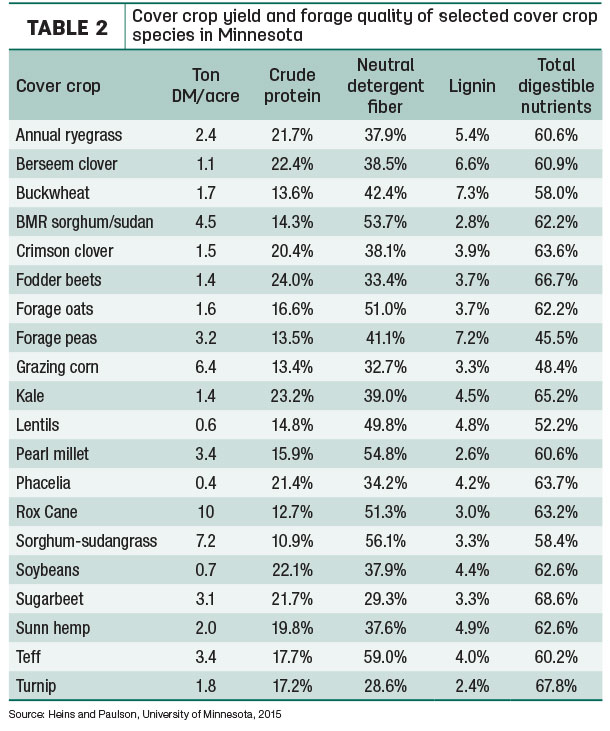Cover crops are “hot topics” in crop systems. Beef producers have used cover crops for fall, winter and spring pasture sources. Dairy producers need to consider adding this system on their dairy farms.
Cover crops are a tool to address several issues on dairy farms including reducing soil compaction, nutrient recycling, avoiding nutrient losses due to erosion, weed control or pest suppression.
Cover plants can trap water that could run off, protect soil surfaces from wind and rain risks, and provide a valuable forage resource for various dairy animals depending on age (yearling heifers), level of milk production (low-production group) and gestation (dry cows).
Several questions are listed below to determine whether your dairy farm should use this tool and whether you are using cover crops correctly.
Q. Why are cover crops a ‘win-win-win’ option?
Answer: One “win” is the improvement in soil texture, nutrient utilization and soil conservation. The second “win” is for the dairy animal, as cover crops can provide an optimal profile of nutrients needed by various groups on the dairy farm (yearling heifers have lower forage quality needs, while high-producing cows require high-quality forage).
Cover crop selection and harvesting at optimal maturity can meet these needs. The third “win” is the dairy manager, providing flexibility in the forage program in case of forage shortages and maximizing feed production by double-cropping available acreage.
Q. What are potential cover crop functions or roles?
Answer: Cover crops can reduce soil erosion, especially during winter when snow cover may be minimal and strong wind removes soil. Water erosion and runoff are minimized when cover crop roots stabilize soil and allow for water penetration. Soil health can be improved as roots penetrate soil and open the soil structure, reducing compaction.
Organic matter can increase in the soil, depending if plant dry matter is incorporated back into the soil or when roots degrade (especially tubers such as radishes or turnips). Soil nutrient profiles can improve due to nitrogen capture with legumes.
The cover crop can remove nitrogen and phosphorus, reducing nutrient levels in soil, preventing leaching of nutrients and balancing the nutrient profile, meeting soil nutrient guidelines (allowing for manure application).
Q. Why should a dairy farmer consider a cover crop?
Answer: Dairy farmers can double-crop their land resources, increasing forage inventory and dairy cattle carrying capacity on their farms. In Illinois, winter wheat provides several options:
- Winterkill of alfalfa can reduce spring forage resources. This loss cannot be predicted until spring, when stem and plant counts can be performed.
- Winter wheat can be harvested as a wheat silage to provide extra forage and allow for another full-season crop such as corn, sorghum or soybeans.
- Quality of wheat silage can vary depending on whether the forage is needed for high-producing cows (harvested at the boot stage or when heads are emerging out of the sheath) or for heifers and dry cows (harvested in the dough stage, doubling dry matter tonnage per acre).
- If forage is not needed, the wheat can be harvested for wheat grain and straw while allowing for no-till drilling soybeans.
Q. What cover crops can be considered?
Answer: Winter cereals are common on dairy farms such as winter wheat, rye and triticale. Legumes such as clover can improve nitrogen balance. Brassicas, including turnips and radishes, can improve soil texture. Cool-season cover crops include grasses such as ryegrass, legumes – including peas – and brassicas. Warm-season cover crops can include annual grasses such as millet, sorghum and sudangrasses. Table 1 lists possible cover crop species.
Q. Small winter cereal grains are popular; what species can be considered?
Answer: Blends of cereal grains along with legumes or brassicas can provide soil improvement and forage nutrient value.
- Cereal rye has potential with high forage yield potential and aggressive growth. The harvest window can be a concern as it changes in quality quickly due to maturity. It allows for spring grazing for dairy heifers and dry cows.
- Triticale is increasing in popularity, as it has a longer harvest window. Forage quality and yield can be a plus. Triticale is my favorite winter cover crop.
- Wheat offers flexibility and alternatives, including forage, marketable grain and straw. Grazing is limited in northern areas as it goes dormant. Wheat is another favorite for its flexibility, as discussed earlier.
Q. What yield and forage quality can be achieved?
Answer: Jim Paulson and Brad Heins, from the University of Minnesota, published data on cover crops including yield and nutrient content in Minnesota. Table 2 compares several cover crop options.

These values will vary depending on growing conditions, soil fertility and harvest stage of maturity.
Q. What limitations or concerns should be considered?
Answer: Seed costs will be a factor varying on the cost per pound (oats can be economical) and the amount seeded. (Oats can be 15 to 17 pounds per acre.) If the cover crop is not harvested as forage, termination of the cover crop must be considered. Due to moisture and soil nutrient uptake, the next crop planted may experience reduced yield.
The financial benefits may not be adequate to encourage planting a cover crop if it is not harvested as a forage crop. If the crop is grazed, about 30 to 40 percent may be consumed, while the remainder is trampled and nutrients are returned to the soil. Trampling can be reduced by pasture management. (Small paddocks or use of electric wire to control access are examples.)
Grazing in the fall, spring and possibly during the winter seasons can provide an optimal forage resource for yearling heifers along with exercise. If you graze cover crops, be aware of the potential risks of bloat, prussic acid levels and nitrates.
Relative cold tolerance should be considered if the forage is going to be grazed. Baling cover crops as hay can be a limitation, as these forages can be high in moisture and harvest may occur when weather and drying conditions are not favorable. ![]()

-
Michael Hutjens
- Professor Emeritus - Animal Sciences Department
- University of Illinois – Urbana
- Email Michael Hutjens






